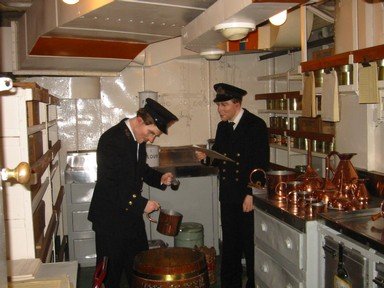Quiz Answer Key and Fun Facts
1. Although first distributed in 1655, it is from 1740 that the modern rum ration, consisting of one part rum to four parts water, was introduced, initially by Admiral Edward Vernon. The drink that emerged was nicknamed "grog", from Vernon's own nickname, "Old Grog". Where did this derive from?
2. While Vernon is responsible for diluting the rum ration, it is a myth that he also ordered the addition of the juice of citrus fruit to grog. The addition of the juice of citrus fruits to grog was ordered by the Admiralty in 1795, when what was added to the diet of ordinary sailors?
3. Although the rum ration was initially for every serving member of the Royal Navy, as time went on it began to be phased out for different ranks so that, by 1918, only those of which rank and below were eligible to receive it?
4. While the ration had been retained from previous attempts to abolish it, the period after the Second World War, which saw ships of the Royal Navy increase in complexity, saw returned efforts to remove the tradition. In 1970, the daily ration was finally abolished in the Royal Navy. Who was the First Sea Lord that oversaw the end of the daily tot?
5. Almost a decade after the end of the daily tot, a company was founded to sell rum produced using the Admiralty's specific blend of five distinct individual rums. What name was given to the company?
6. Although the Royal Navy did away with the rum ration in 1970, it was retained after this by other navies. Which Commonwealth country's navy was the last to abolish the tot?
7. While the daily ration has ended, the distribution of a tot to the ship's company on special occasions is still permitted, and is done on receipt of the order "Splice the Mainbrace". But what is a mainbrace?
8. When the ration was served daily, it was distributed from a special container referred to as the "grog tub" (or "rum tub"). Because it was issued to personnel by the service, and thus by extension by the sovereign, a toast was fitted in brass letters to the front of every grog tub. What did this read on the last day of the rum ration's issue?
9. Although there were minor variations from ship to ship, the basic procedure for issuing the daily tot was broadly the same, and, unless they were on watch, took place between 11.00am and 12.00 noon for most members of the ship's company. However, members of which branch of the Royal Navy had to receive their daily tot at the end of their working day?
10. The Royal Navy has been the source of traditions subsequently introduced into other navies, and the daily ration was no exception. But, it was not always rum that ended up being distributed. In 1808, the US Navy switched the daily tot from rum to what other spirit?
Source: Author
Red_John
This quiz was reviewed by FunTrivia editor
stedman before going online.
Any errors found in FunTrivia content are routinely corrected through our feedback system.
